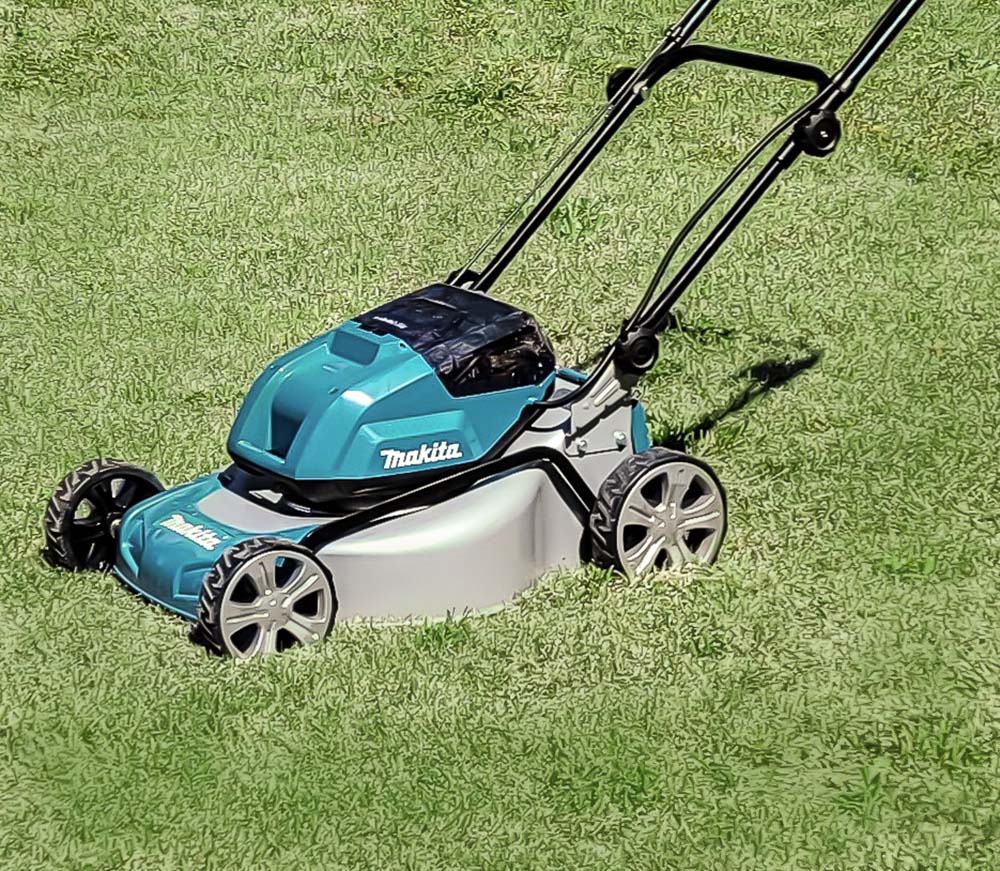

We may earn revenue from the products available on this page and participate in affiliate programs. Learn More ›
Maintaining a regular mowing schedule is vital to achieving lush and healthy turfgrass. However, a battery-powered lawn mower is worth considering if you prefer a quieter and eco-friendly option to loud gas-powered mowers. I have plenty of experience with lawn mowers, but until now, they’ve all been gas-powered models. I put off buying a battery-powered electric lawn mower because many models are pricey, plus I had my doubts that the batteries would last long enough to mow my entire yard. I was wrong.
Thanks to constant improvements in rechargeable batteries, manufacturers like Makita—an industry leader in battery-operated tools and appliances—are producing some of today’s best battery-powered lawn mowers. I’ve used dozens of Makita cordless tools over the years, and I’ve come to know the brand for its high-quality workmanship and cutting-edge technology. Recently, I got the chance to test a Makita lawn mower—the XML03, an 18-inch model—in my own yard. Over 3 weeks, I mowed a large section of my yard (about ⅓ acre) six times—twice per week—with the XML03. Keep reading to find out how the Makita mower fared in my hands-on testing and learn the features I liked best, plus a couple I wish Makita would consider changing.
The Makita XML03 Brushless Cordless 18-Inch Lawn Mower: At a Glance

Rating: 9.5/10
PROS
- Eco-friendly battery power eliminates the need for carbon-producing gas and oil
- Quieter than fuel-powered mowers—early morning mowing won’t bother neighbors
- 4 batteries included with purchase; when 1 set runs down, swap in a charged set
- Handle located in front of mower for easy (and safe) lifting
- Simple push-button start—no cords to pull or pumps to prime
- Fold-down handles reduce storage-space requirements in a garage or shed
CONS
- Relatively narrow 18-inch swath width can make it time-consuming to mow large yards
- The Makita XML03 is not self-propelled and can be challenging to push on inclines
- Grass-clipping bag is on the small side and may require frequent dumping
Get the XML03 Makita electric lawn mower at:
What is the Makita lawn mower?
The Makita XML03 is a battery-powered lawn mower with an 18-inch-wide cutting swath. The mower’s relatively narrow swath width puts it in the category of a small-to-medium yard mower. Makita claims the four batteries, which are included, will mow up to ⅓ acre on a single charge. However, the XML03 is not a self-propelled mower, so the actual area it will mow will depend on how quickly you push the mower and how thick the grass is. The Makita lawn mower has a detachable grass-catching bag and an optional mulching attachment. The bag holds up to 1.7 bushels (16 gallons) of grass clippings, and I emptied the bag an average of six times every time I mowed the test area.
The XML03 features a single mowing blade that spins at up to 3,300 revolutions per minute (rpm). That’s right in-line with gas-powered mowers that typically range between 2,800 and 3,600 rpm. But rpm also depends on resistance—because the thicker or higher the grass, the more resistance the blade will run into, which can slow down the spinning speed. This is also a factor with gas-powered mowers but to a lesser extent. The best mowing practice for any lawn is to cut no more than ⅓ of the grass blade. This will require mowing more frequently during spring and early summer when grass grows the quickest. Cutting ⅓ of the grass blade or less puts less strain on a mower, and it’s better for the health of the grass.
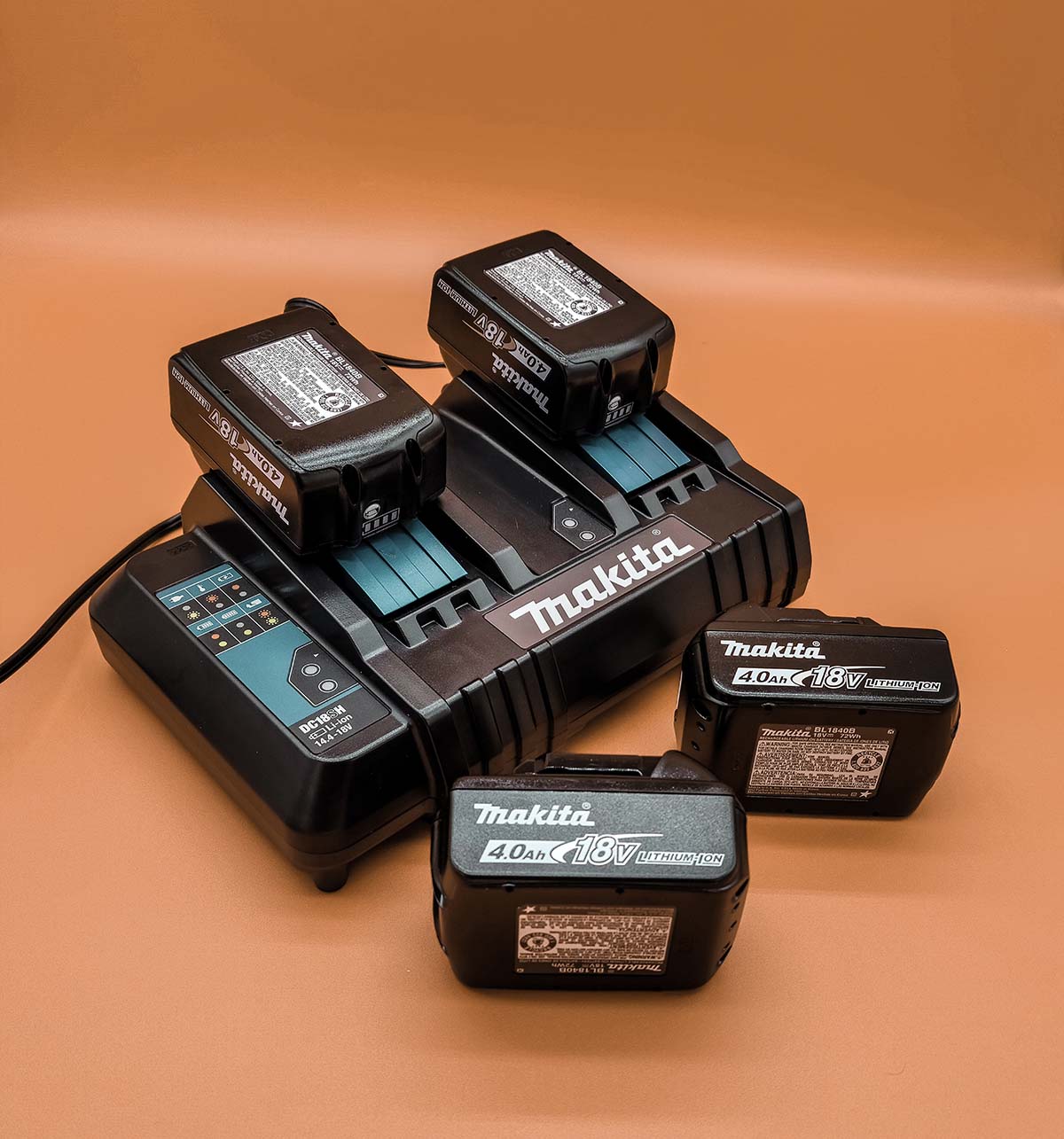
How long do the batteries last when mowing with the Makita lawn mower?
One of my goals when testing the Makita lawn mower was to see if it would meet the manufacturer’s claim of mowing ⅓ acre without stopping for recharging of the batteries. The XML03 runs on two 18-volt batteries simultaneously, giving it the equivalent of 36 volts of power. The batteries that come with the mower are 4.0 amp hours (Ah), which are considered mid-to-high capacity batteries.
Before each mowing test, I fully charged all four batteries. In all but one of the six times I mowed, the batteries not only lasted long enough for me to finish cutting the test area, but I also still had some leftover charge according to the battery indicator on the handle. The only time I could not mow the entire test area—a 130-feet-long by 112-feet-wide section—was when the grass was still damp from an overnight rain shower. Even the best cordless lawn mowers are typically a bit less powerful than gas-powered mowers.
Mowing when the grass is damp increases the resistance on the cutting blade, plus it’s not a good idea to mow wet grass for the health of the turf—but I wanted to conduct a thorough test. I had just two strips of lawn left to go when the second set of batteries ran down. But when the grass was dry, I had no problem cutting the entire test area.
The XML03 has a brushless motor, which helps with both power and battery runtime, but remember that lithium-ion batteries lose power over time. For the best battery life, always charge the batteries completely before use. In addition, remove batteries from the charger when they’re fully charged, which is better for battery health.
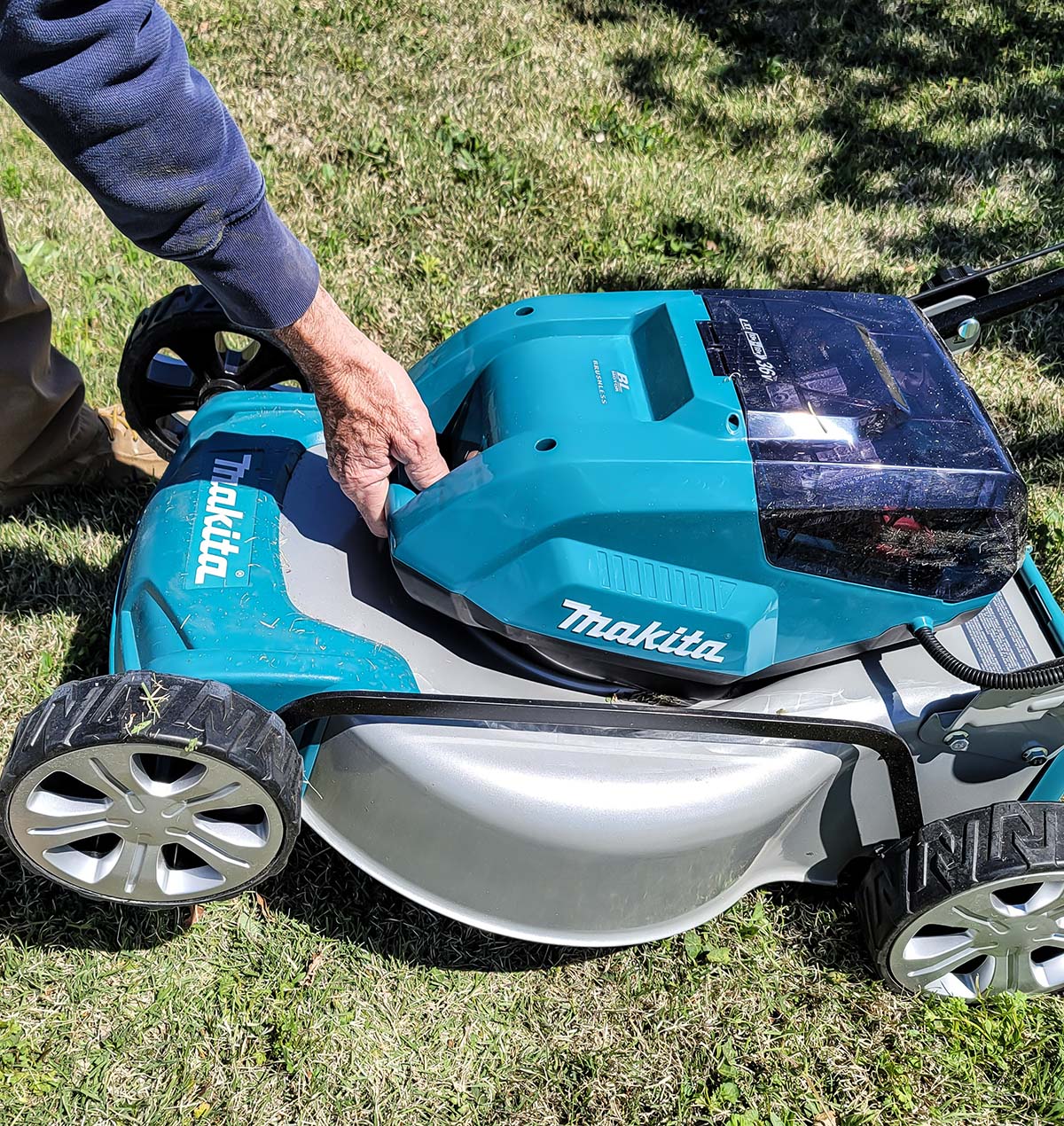
Is the grass-cutting height on the Makita lawn mower adjustable?
Nearly nothing could be simpler than adjusting the mowing height on the XML03. It features a universal adjustment lever on the back right wheel. I found it easy to use the height-adjustment lever to raise or lower the mower’s deck height as needed. While adjusting the height is easy, however, this is also where I feel Makita could have done a little better. The XML03 cuts as low as 13/16 inch and as high as 3 inches. The lowest height adjustment works well for the buffalo grass I have planted in the front of my yard, but I also have tall fescue growing in another area, and I like to keep it mowed at 3½ inches. Still, 2½ to 3 inches is a typical height for many types of grass, so not being able to raise the deck height to 3½ inches wasn’t a deal breaker for me.
How does the Makita lawn mower compare to a traditional gas mower?
A gas-powered mower will run as long as you have gasoline to dump in the tank. The Makita XML03 will run as long as the batteries retain a charge. Buying an extra set of Makita batteries will increase overall runtime, so if you need to mow more than ⅓ acre at one time, consider investing in another set or two of Makita 18-volt rechargeable batteries.
The last couple of gas mowers I owned came with start buttons, but they stopped working after a few months, and I had to pull the starter cord to get the engines to fire. The Makita lawn mower has the easiest start of all—I just turned on the mower from the control panel on the handle, pushed the button, and the motor started right up. There’s no need to repeatedly pull a start cord, and no smoke or fumes.
The most significant differences between the Makita lawn mower and traditional gas mowers are noise and pollution. A conventional gas mower can generate up to 95 decibels of noise—anything over 85 decibels may damage hearing. Many electric mowers top out around 75 decibels, but according to my decibel tester, the Makita XML03 generated even less noise—about 71 decibels. For comparison, a typical vacuum cleaner generates about 70 decibels.
There’s no question that a battery-powered lawn mower is more eco-friendly. There’s no gasoline to buy or store (a fire hazard), plus there are no toxic fumes emitted as you mow. The sustainability value alone is reason enough for me to consider switching to a more eco-friendly way to mow.
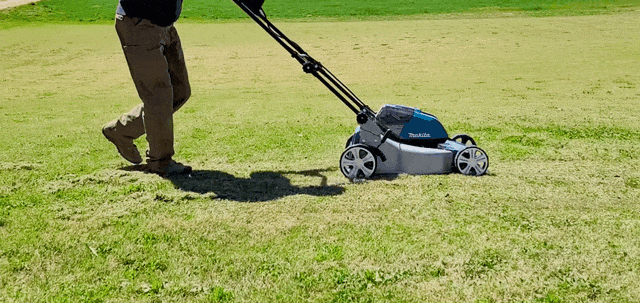
How easy is the Makita lawn mower to maneuver?
The Makita XML03 is not a self-propelled mower, so I had to push it along physically. That said, I didn’t find it too difficult to push. The wheels roll smoothly, but it’s strictly a mower for a flat yard. I tried pushing it up and down slopes as well as horizontally along the sides of slopes. Mowing down a slope was super easy, but pushing the mower up an incline was challenging, to say the least.
Mowing horizontally on an incline was less demanding, but like most mowers, the XML03 tended to slip downward as I mowed. Although the XML03 isn’t self-propelled, some battery-powered lawn mowers are, such as the DeWalt 2X20V MAX that another Bob Vila product-testing team member recently tested.
Making uniform back-and-forth turns was easy, but I discovered something as I was mowing the test area—the Makita lawn mower doesn’t leave noticeable wheel stripes in the lawn. I guessed this was due to its relatively light weight—63.3 pounds with batteries—compared to my gas-powered mowers, which weigh closer to 100 pounds. Less weight on the tires leaves less of a track behind in the grass.
Maneuvering isn’t only about pushing and turning a mower; it’s also about how easy it is to clean out from under the mowing deck and sharpen the blade. It was nice to tip the Makita lawn mower over on its side to access the underside without oil draining out of a tank (like a gas mower). I was cautious about removing the batteries before tipping it over. Included with the mower, Makita sent along a T wrench that fits the nut that holds the blade in place. That’s a nice perk that I’ll appreciate when sharpening or replacing the blade.
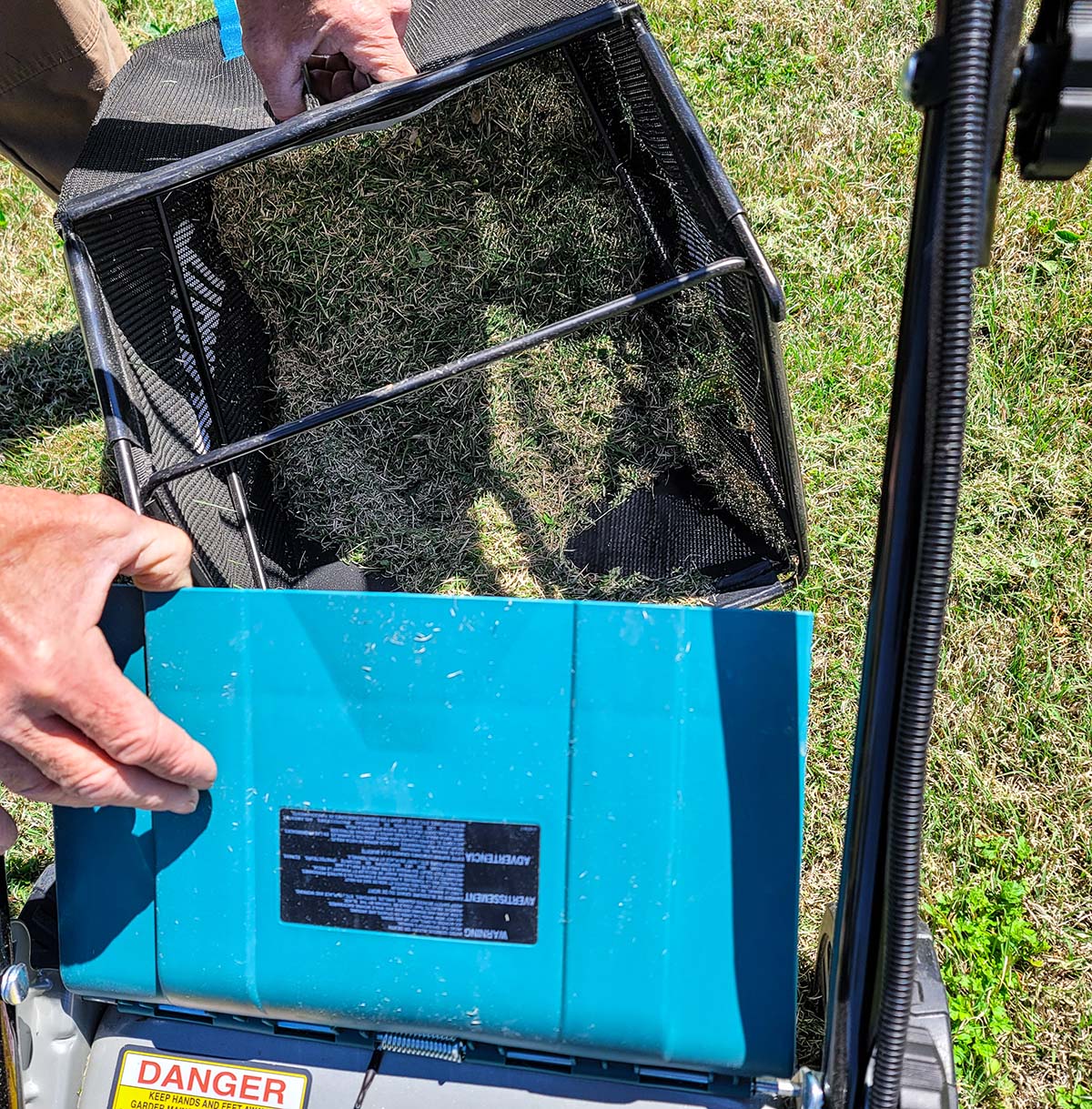
Should you buy a battery-powered Makita lawn mower?
Before buying the Makita lawn mower, or any battery-powered mower, consider a few things. While the XML03 sells for a reasonable $399 at a handful of retailers, many battery-powered mowers are significantly more expensive than comparable gas-powered ones. Makita can keep the price down on the XML03 by offering a narrow (18-inch) swatch width and omitting a self-propulsion feature. This is an excellent option for when I need to mow early in the morning without waking up the rest of the family and for reducing my carbon footprint.
It takes a little bit more energy and strength to push a nonpropelled mower, but I found that by mowing frequently—so the grass wasn’t too high between mowings—and by cutting only when the grass was dry, the mowing process was pretty enjoyable. However, if you’re not thrilled about pushing a mower, this might not be the best lawn mower for you. The XML03 is among the smaller electric mowers available. However, it’s perfect for those who are serious about reducing greenhouse gas emissions while still having a perfectly manicured lawn.
Where to Buy the Battery-powered Makita Lawn Mower
Get the XML03 Makita electric lawn mower at:
Meet the Tester
Glenda Taylor is a seasoned product tester and writer focusing on construction, remodeling, and DIY home improvement. As a general contracting company co-owner with experience in residential and commercial building applications, she brings a wealth of knowledge and expertise to her reviews. She tests and reviews a wide range of products, including power tools, household appliances, and lawn-and-garden products to help consumers make informed decisions.
